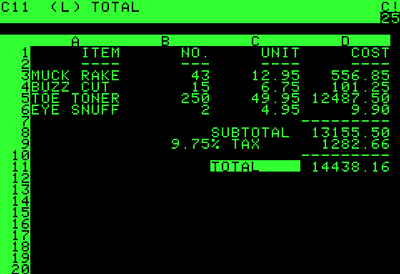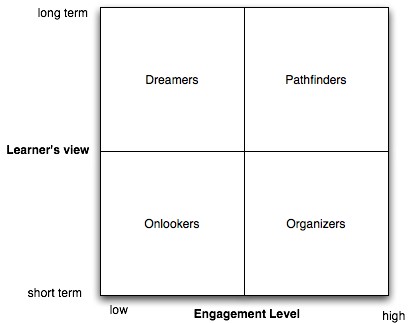Interaction Design
Interaction Design is the art of facilitating interactions between humans through products and services. It is also, to a lesser extent, about the interactions between humans and those products that have some sort of “awareness”—that is, products with a microprocessor that are able to sense and respond to humans. - Dan Saffer (2007)
Almost anyone can produce content, but it takes a good Instructional Designer to add awareness. Saffer (2007) partially defines this awareness as the product being able to sense and respond to the user. For Instructional Designers, this means the elearning platform should be able to respond and guide the learners in their quest to master a new skill or task. For some related techniques, see Designing for Agile Learning.
Interaction design is considered contextual as it relates to a situation by solving specific problems under a set of circumstances. For example, VisiCac was the first spreadsheet program available for personal computers—it was one of the main reasons the Apple II became a best seller at the time as it allowed business owners to easily perform what/if calculations.

Although it was a fantastic piece of software for its time, you would be hard-pressed to find anyone using it nowadays because it has been replaced by better software. This contextual nature of Interaction Design is mainly influenced by three forces that support a learning platform:

Business Need
Normally, the primary purpose of a learning platform is to help the organization achieve a goal (normally referred to as a Business Outcome or Business Linkage). In order for the learning platform to achieve the organization's initiatives, strategies, and goals it must have certain interactions built into it that allow the learners to master the new skills that will achieve these goals. (Garnevale, Gainer, Villet, 1990). Since initiatives normally change over time, a particular learning platform will either change or become obsolete.
Learner's Framework
While the above contextual nature of Interaction Design shows its connection to the needs of the business, the Learner's Framework shows that we must also identify the needs of the learners.
Bill Moggridge (2007) writes about a framework that is geared towards developing web interactions by showing a person's needs and behavior for a particular project or task. This framework could also be used to target the needs of learners. The framework is a two-by-two matrix with a vertical axis describing the view of the learner with a long-term view at the top and a short-term view at the bottom. The horizontal axis shows how engaged the learner is, with low engagement on the left and high engagement on the right:

- In the top right hand corner are Pathfinders who are fully engaged and take a long-term perspective. These learners require full mastery of the skills.
- Below them, in the bottom right-hand corner, are Organizers who are highly engaged but take a short-term view.
- Next door to them, in the bottom left-hand corner, are Onlookers who take a short-term view and have low engagement.
- Above them, in the upper left-hand corner, are Dreamers who have a long-term view, but have low engagement.
A Pathfinder is someone who really needs to learn the task because she is going to be using it for the long-term and will be fully engaged during the entire time frame. Training or a blended platform will normally be called for and if the task is highly complex, an in-depth performance support package might also be needed.
Organizers are engaged by the task, but don't view themselves as being the primary task-holders. They might be a supervisor who needs to learn about the task, a person who will fill in part-time as a backup, or the task might simply be for the short-term. A just-in-time learning package, such as elearning might be used to give them the basic knowledge, followed by a highly detailed support package (job-Performance-Aid) that allows them to perform at the minimal requirements for a short period of time if needed.
Onlookers are not fully engaged in learning the task because they will not be performing the task; however, they are fully engaged in other closely related tasks, thus they need to see how that task relates to them. A basic elearning package that gives an overview of the task and how it relates to the organization might be a proper fit.
Daydreamers have a long term view because they see it as a means to something else, rather than an end; for example, a means to do another task or job. However, they do not want to waste a lot of time learning the task, thus a quick and dirty elearning or the cheapest performance support band-aid available.
Building the Learning Platform: The Four Lenses of Interaction Design
According to Saffer (2007), there are four main approaches to Interaction Design:
- Performance or Activity-Centered Design
- Guru or Genius Design
- Learner or User-Centered Design
- System Design
Most learning platforms can be built using a combination of these designs; however, normally one of them is prominent.
Performance-Centered Design
This design focuses on the tasks that are composed of actions and decisions that the learners need to perform. A Learning Designer uses an Exemplary Performer as a model and then they build the instructional content and add awareness to it.
Guru Design
Guru Design focuses on the skills and knowledge of Subject Matter Experts. A Learning Designer interviews one or more SMEs as knowledge sources and then they build the instructional content and add awareness to it.
Learner-Centered Design
This type of design focuses on the needs and goals of the learners who guide the design; while the Learning Designer aids with the content and awareness. It is based on the concept that the people who use a product or service know what their needs, preferences, and goals are, thus they and the Learning Designer collaborate throughout every stage of the design process to build the content and awareness.
It should be noted that the vast majority of so called “Learner-Centered” Designs in use today are based on the other three design techniques because they focus on what others think the needs and goals of the learners should be, not what the learners think they should be—that is, they rarely use the learners as the primary information source.
System Design
System Design focuses on the system's inputs, outputs, processes, feedback loops, goals, etc. to guide the design. Note that ISD models, such as ADDIE, are combinations of System Design, Guru Design, and Performance Centered Design.
For more information on how these four approaches are used, see Designing for Agile Learning.
Next Steps
-
Interaction Design
Related Resources
References
Garnevale, A., Gainer, L., Villet, J. (1990). Training in America: The Organization and Strategic Role of Training. San Francisco: Jossey-Bass.
Moggridge, B. (2007). Designing Interactions. Cambridge, Massachusetts: The MIT Press.
Saffer, D. (2007). Designing for Interactions: Creating Smart Applications and Clever Devices. Berkeley, CA: New Riders.


